Do you experience pain or numbness in your arms or hands?
If so, you may suffer from thoracic outlet syndrome (TOS). This condition occurs when the nerves or blood vessels in the thoracic outlet, the space between your collarbone and first rib in your shoulder region, become compressed. TOS can be a debilitating condition, but there are treatment options available.
Osteopathy is a form of manual physical therapy that focuses on the musculoskeletal system and its relationship to the body as a whole. It can be an effective treatment for TOS, as it aims to restore proper alignment and function to the affected area.
If you are struggling with TOS, seeking proper treatment to alleviate your symptoms and improve your quality of life is essential. Osteopathy is a gentle, non-invasive approach that can help address the underlying issues causing your TOS.
It occurs when the neck and shoulder muscles become tight and short, pulling up the first rib and entrapping either the nerves or blood vessels that supply the arms or both.
This entrapment causes both the painful sensation when the arms are held above the head and the morning numbness in the hands and arms.
This neck muscle tightness can be caused by overtaxing the neck and shoulders at work or while playing sports, or it can be caused by an upper back and neck postural problem.
People may experience pain and restrictions in the neck and shoulders, as well as symptoms in the arms, as a result of this repetitive strain.
When the nerves leading from the neck to the arm (the brachial plexus) become compressed, neurogenic TOS occurs. More than 90% of the cases are neurogenic.
Venous TOS occurs when a vein becomes clogged, resulting in upper-body thrombosis. Only 5% of cases are venous.
When an artery is compressed, it causes TOS. Only about 1% of the cases are arterial.
The venous and arterial thoracic outlet syndromes are sometimes called vascular thoracic outlet syndrome. A combination of venous and arterial thoracic outlet syndrome can also occur.
Different types of thoracic outlet syndrome necessitate different treatments.
One of our osteopaths at Foundation Health Osteopathy will conduct a comprehensive assessment, diagnosis, and treatment plan for your symptoms. We use specific tests to determine whether your symptoms are caused by thoracic outlet syndrome or another condition.
Osteopaths treat TOS regularly by relaxing the tight muscles around the neck and shoulders, allowing the first rib to lower and giving the blood vessels and nerves more room to function correctly.
Soft tissues, joint mobilisation, and stretching can all be used to help reduce muscle tension around the thoracic outlet.
These techniques may aid in promoting blood flow and lymphatic drainage, which may aid in the reduction of inflammation and swelling.
Your Osteopath will provide advice on some daily changes you can make to help reduce symptoms.
The importance of treatment to improve range of motion and posture cannot be overstated. We prescribe some basic exercises to help with abdominal breathing, posture correction and postural strengthening, which are essential components of thoracic outlet syndrome recovery.
Strengthening your shoulder and back muscles is critical for long-term relief while stretching your shoulder and neck muscles to open the thoracic outlet space will provide symptomatic relief and pain relief.
Furthermore, we provide stretches to keep the muscles in good shape and exercises to improve posture to prevent this condition from recurring. These exercises performed over time relieve pressure on the blood vessels and nerves in the thoracic outlet.

If you’re struggling with thoracic outlet syndrome, osteopathy may be the solution you’ve been searching for. With a focus on holistic, non-invasive treatments, osteopathy can help you reduce pain, improve mobility and get back to living your life to the fullest.
Don’t let thoracic outlet syndrome hold you back any longer—consider giving osteopathy a try today.
Book an appointment at Foundation Health for osteopathic treatment for your thoracic outlet syndrome.
Are you feeling dizzy or unsteady on your feet? You may be experiencing vertigo, a common condition that affects many people. Vertigo is not a disease, but rather a symptom that can be caused by a variety of underlying conditions.
People with vertigo often feel that they or objects around them are moving when they are not, which can cause feelings of light-headedness, imbalance, and nausea. Vertigo can have a significant impact on a person’s daily life, affecting their ability to work, drive, and even perform simple tasks.
In this article, we will explore the causes, symptoms and treatment options for vertigo.
Vertigo is a type of dizziness that can cause a range of symptoms. The most common symptoms of vertigo include a sensation of spinning or whirling, feeling off-balance or unsteady, and experiencing nausea or vomiting.
Other symptoms may include headaches, sweating, ringing in the ears, and difficulty focusing or concentrating. In some cases, people may also experience symptoms such as double vision, difficulty speaking or hearing, and a feeling of pressure or fullness in the ears.
It is important to note that the severity and duration of these symptoms can vary from person to person and may be indicative of different underlying conditions.
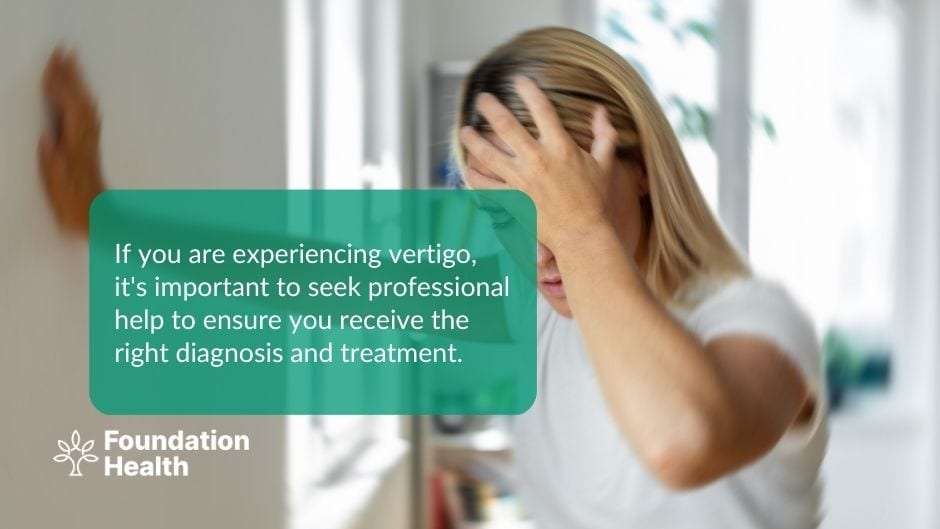
The inner ear is a complex structure that is responsible for our balance and spatial awareness. It contains small crystals that help detect the direction and speed of head movements, but when they become dislodged, they can cause vertigo.
The crystals move through the fluid, activate nerves in the canals, and send signals to the brain that make it think our head is moving when it’s not. This creates a mismatch of information between our senses and brain, leading to the unpleasant sensation of vertigo.
Foundation Health Osteopathy provides effective treatment options for various types of vertigo. If you’re experiencing symptoms of vertigo dizziness, it’s recommended to see your GP first. However, if you are referred to us for further assessment and treatment, our team of osteopaths will conduct a comprehensive examination to diagnose your condition.
Depending on the type of vertigo you have, treatment options may include repositioning manoeuvres, medication, and lifestyle changes. Repositioning manoeuvres involve a series of head movements and positioning exercises to move dislodged crystals back to their original location in the inner ear. The Epley manoeuvre and the Brandt-Daroff exercise are two common repositioning manoeuvres used to treat BPPV.
Medication may also be prescribed to manage symptoms of nausea and vomiting. Lifestyle changes such as avoiding sudden head movements can also be recommended to reduce the risk of future vertigo episodes.
At Foundation Health Osteopathy, our aim is to provide comprehensive care for patients with vertigo. Our team of osteopaths are dedicated to helping you find relief from your symptoms and improve your quality of life.
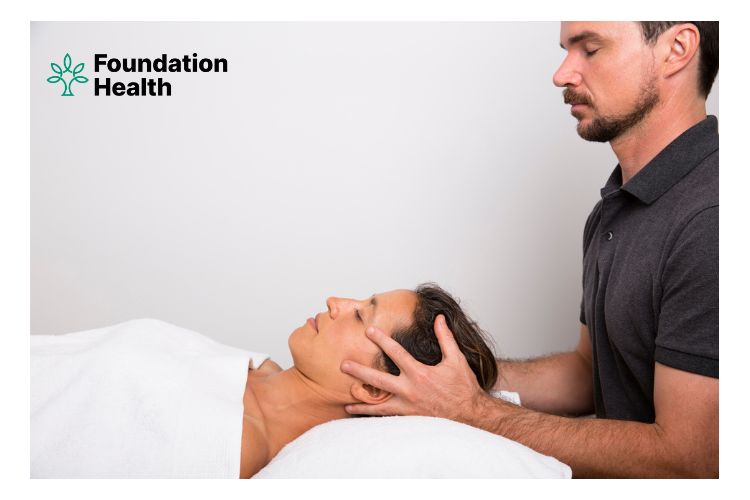
Contact us for an assessment and treatment plan if you’re experiencing symptoms of vertigo.
If you’re experiencing vertigo, it’s important to seek professional help to ensure you receive the right diagnosis and treatment. Here at Foundation Health Osteopathy, our team of osteopaths can assess your symptoms, determine the cause of your vertigo, and develop a tailored treatment plan to help you find relief.
Trying to manage vertigo on your own can be difficult and may not address the underlying cause of your symptoms. Our team of health professionals has the knowledge and resources to provide you with the best possible care.
Don’t let vertigo impact your daily life any longer. Contact Foundation Health Osteopathy today to schedule an appointment and take the first step towards feeling better.
Osteopathy is a holistic approach to healthcare that focuses on the body’s musculoskeletal system. It is a form of manual therapy that can be used to treat and prevent occupational musculoskeletal pain. Osteopathic treatment involves manipulating the body’s soft tissues, joints, and muscles to restore balance and improve function.
Osteopathy is an effective treatment for occupational musculoskeletal pain because it can help to reduce pain and improve mobility. It can also be used to prevent occupational musculoskeletal pain from occurring in the first place.
Osteopathic treatment can help to reduce the risk of developing occupational musculoskeletal pain by addressing the underlying causes, such as poor posture, repetitive motions, and insufficient rest periods.
Occupational musculoskeletal pain are injuries or conditions of the muscles, nerves, tendons, ligaments, joints, cartilage and other soft tissues caused by repetitive motion and improper body mechanics.
These types of injuries can result from work-related activities such as lifting heavy objects, using vibrating tools for extended periods and performing certain tasks in awkward postures.
Commonly referred to as ergonomic-related injuries or workplace-induced injuries, occupational musculoskeletal pain can be painful and restrict movement.
Symptoms include pain, stiffness, aching and/or numbness in the affected area. In some cases, individuals may experience weakness or fatigue that affects their ability to perform daily tasks.
With prompt treatment and careful management, most occupational musculoskeletal pain can be prevented and/or managed effectively.
Work-related musculoskeletal pain is classified as overuse injuries and overexertion injuries.
Overuse injuries at work, also known as repetitive strain injuries, include various inflammatory and degenerative pain.
Carpal tunnel syndrome, shoulder impingement syndrome, lateral epicondylopathy, and tendinopathy of the wrist or hand are a few examples. These conditions are commonly associated with repetitive, forceful, or awkward movements.
Overexertion injuries occur when muscles, ligaments, or tendons are overstressed during resisted movement. Overexertion mechanisms include lifting, pushing, pulling, or carrying weights that exceed a person’s capacity.
In an ergonomically poor workplace, joints, muscles, and tendons are subjected to biomechanical stress due to awkward movements and postures. There is a risk of injury when tissues are put under greater demands than they are structurally or physiologically capable of meeting.
These risk factors result from ergonomic stresses caused by prolonged or awkward postures, repetition without adequate recovery time, or the need to lift or move heavy loads.
Some ergonomic stressors put soft tissues in close contact with bone, causing friction and inflammation, while others put undue strain on muscles and connective tissues. The worker is likely predisposed to these effects due to baseline postural abnormalities and dysfunctional movement patterns.
Slips, trips, falls and blows also cause injuries among workers. These injuries are usually caused by environmental or performance problems.
It is possible to reduce the risk of occupational musculoskeletal injuries and disabilities by ensuring that demands are matched to capacity, correcting dysfunctional movement patterns, and limiting tissue vulnerability to stress.
The goal of osteopathic treatment is to restore normal thoracic spine and rib cage mechanics while also improving transverse diaphragm movement.
Osteopathic treatment can also be used to improve the ergonomics of a workplace. By assessing the work environment and making adjustments, such as suggesting ergonomic chairs and desks, osteopaths can help to reduce the risk of developing an occupational musculoskeletal disorder.
In the workplace, interventions are implemented to reduce or eliminate stressors that overwhelm an individual’s capacity to accommodate or adapt to these conditions. As a result, musculoskeletal strain will be prevented.
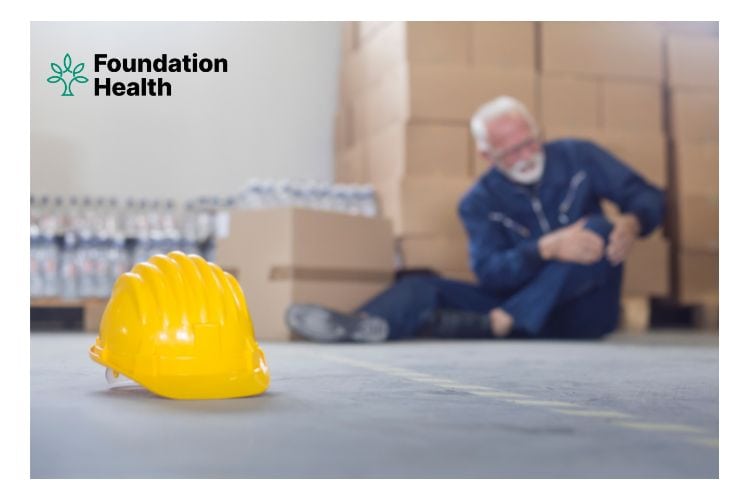
Overall, osteopathy is an effective treatment for occupational musculoskeletal pain and can be used to both treat existing conditions and prevent them from occurring in the first place.
By addressing the underlying causes of occupational musculoskeletal pain, such as poor posture and inadequate rest periods, osteopathic treatment can help to reduce the risk of developing an occupational musculoskeletal disorder.
In addition, it can also be used to improve the ergonomics of a workplace and treat other conditions such as headaches, neck pain, and back pain.
Book an appointment at Foundation Health for osteopathic care for occupational musculoskeletal pain!
Do you experience dizziness, lightheadedness, or vertigo often? It can be incredibly frustrating and limiting. Vertigo is an unsettling condition that can cause a person to feel like they are spinning or moving even when they are stationary.
While there can be many causes for vertigo, one relatively unknown solution is osteopathy. Osteopathy is a manual therapy that uses specific techniques to treat the body as a whole.
Osteopathy is an effective treatment for vertigo and can help patients regain their stability and quality of life.
Vertigo is a symptom of a medical problem, not a disease in and of itself. Vertigo is a common condition that affects approximately 40% of the population at some point in their lives. Vertigo is a complex condition frequently caused by several factors and is hardly straightforward.
Vertigo sufferers describe the sensation as “dizzy spells” and “the room spinning” when moving their necks or changing positions. This dizziness can cause nausea, vomiting, and the sensation that one’s eyes are flickering.
The most common type of vertigo is benign paroxysmal positional vertigo (BPPV), which accounts for 20% of all dizziness episodes. It is critical to have a medical practitioner evaluate the cause of vertigo since multiple factors, conditions, and diseases can cause it.
It can be divided into a few broad categories. These are problems with your blood pressure or blood pressure medications, other medications, inner ear infections, a virus, problems with your neck that affect a specific nerve, and benign vestibular apparatus problems that governs balance.
The most common cause of vertigo is benign paroxysmal positional vertigo (BPPV). BPPV is actually an ear condition that gives you a sudden spinning sensation as if your head is spinning from within. This can last for seconds or days.
BPPV is caused by crystals in your inner ear moving from their normal position and circling the ear canal. The increased movement of the crystals gives the brain a false sense of motion when moving the head.
When people have vertigo, they feel that the room is spinning, especially when they move into certain positions, such as rolling over in bed.
A problem in the part of the inner ear that controls balance causes peripheral vertigo. The vestibular labyrinth or semicircular canals are the names given to these areas. The vestibular nerve may also be involved in the problem. This is the nerve that connects the inner ear to the brain stem.
A series of very gentle treatments to relieve pressure and irritation in your neck, combined with the most recent vestibular apparatus rehabilitative exercises, can significantly reduce your symptoms.
It’s incredible how a patient with severe vertigo can improve dramatically with gentle, targeted treatment.
Treatment includes a series of head movements that helps to dislodge the crystals that form in the ears allowing very rapid relief of the spinning sensation.
We strongly encourage you to try gentle osteopathic treatment to relieve and treat your vertigo because we believe it is a very effective treatment regime.
Alternative medical treatments, such as taking stematil, do not address the cause of your vertigo but may relieve your symptoms. The bombardment of tests you can receive in the hospital is quite unpleasant. It should be avoided if at all possible.
Craniosacral osteopathy is an effective treatment option for people who suffer from chronic peripheral vestibular pathology.
Fortunately, your osteopath can help you relieve the symptoms of BPPV-related vertigo. Your osteopath may use simple positioning techniques and a series of questions to help categorise the symptoms to determine which type of vertigo is present.
Many people who suffer from vertigo benefit from vestibular rehabilitation training (VRT), which is a series of exercises for people who suffer from dizziness and balance problems.
If you have vertigo, the best thing you can do is lie down in a quiet, dark room, close your eyes, and take deep breaths. This may help alleviate nausea and reduce the sensation of spinning.

Traditional treatments like medication and surgery may not be the right fit for all patients with vertigo.
We think you should consider osteopathy as a treatment option. Osteopaths are specially trained to treat the whole body, not just the symptoms. We can help to restore balance and reduce or eliminate your vertigo symptoms.
If you are suffering from vertigo, don’t hesitate to explore the possibility of osteopathic treatment. You may be surprised at how well it works!
Have you been experiencing pain in your jaw joint? Are you finding it difficult to open your mouth wide? You may be suffering from TMJ dysfunction. While this condition can be frustrating and uncomfortable, the treatments available can help you get relief.
One such treatment is osteopathy. Osteopathy is a form of manual therapy that can help ease TMJ dysfunction symptoms. Osteopathy is a holistic approach that considers all aspects of your health, and it may be just what you need to get relief from your TMJ pain.
The temporomandibular joint (TMJ) is the main joint in your jaw. It is one of your body’s most frequently used joints. It participates in daily activities such as chewing, talking and yawning. In fact, you use your TMJ every time you move your mouth.
Temporomandibular dysfunction (TMD) refers to conditions affecting the jaw and surrounding muscles. TMD is an unexpected and painful ailment that can be a significant issue for sufferers because there is little opportunity to rest your jaw, even if it hurts. This is due to the fact that we use our jaws for so many vital functions throughout the day.
The following are the most common TMD symptoms:
TMJ dysfunction is a broad term to describe issues with this joint. Many structures in and around the joint, including the muscles, joint surfaces, and a small disc that sits inside, can cause problems.
Muscle imbalances are common and can cause stiffness or pain (or both) when you open and close your mouth.
There are several possible reasons for tight muscles in the neck area, including jaw trauma (such as when you are punched or hit your chin after a fall), clenching while sleeping (called bruxism), poor posture, and neck dysfunction, or dental problems such as an uneven bite.
People who are highly stressed frequently clench their jaws while sleeping, which can result in waking up with a sore jaw or headaches.
A small disc slides and moves inside the joint during jaw movements. Sometimes this disc can become “displaced” and may not slide and move as smoothly as it should. This frequently results in a jaw that clicks or cracks when opening the mouth.
The click is generally painless, but some people may experience pain in addition to the click. In severe cases, the jaw may temporarily lock, which would be highly distressing to experience.
Jaw joint pain can occasionally manifest as ear pain.
Osteopaths are known for taking a comprehensive approach to examination and treatment. Seeing as TMD is rarely an isolated problem, your jaw, neck, head, shoulders, and upper body may need to be examined and treated if they are contributing to your TMD symptoms.
Osteopathic manual therapy relieves pain, reduces inflammation, and restores function. As the earliest form of intervention, this type of TMD treatment should be administered as soon as symptoms appear.
Your osteopath will do the following to relieve your TMJ pain:
Osteopaths have several techniques that can be used to relieve tension and realign the jaw and its associated structures. We’ve discovered that it responds exceptionally well; most people report a significant improvement in symptoms, pain and realignment.
If misalignment is caused by postural or muscular issues, osteopathic treatment can help to alleviate your symptoms and relax any jaw muscle spasms.

Relief is available if you’re one of many suffering from TMJ dysfunction. Osteopathic treatment is an effective way to relieve pain and restore function. Osteopathic care is tailored specifically to each individual and can relieve many people who have had little success with other treatments.
The most crucial aspect of any injury is determining the correct diagnosis, so please consult with one of our experienced osteopaths at Foundation Health if you think you may be suffering from TMJ dysfunction.
You can get back to living a healthy, happy life with proper diagnosis and treatment.
Approximately 4.0 million Australians (16% of the population) experience back pain, according to the Australian Bureau of Statistics 2017–18 National Health. According to statistics, 70–90% of people will experience some form of lower back pain during their lives. Furthermore, most back problems are associated with chronic pain.
Chronic back pain refers to a range of conditions affecting the bones, joints, connective tissue, muscles, and nerves of the back. The neck (cervical spine) and upper back (thoracic spine), as well as the lower back (lumbar spine) as well as the sacrum (coccyx), can be affected by these conditions.
Fortunately, one of the most effective treatments for chronic back pain is osteopathy, the fastest growing branch of allied health in Australia.
Chronic back pain is related to issues associated with posture and injuries.
Diseases such as osteoarthritis, disc disease, osteoporosis, and some genetic conditions can contribute to chronic back pain.
Other factors may increase your risk of developing back pain like age, physical fitness, smoking, being overweight, and the type of work you do.

Some of these sound like they could incite fear or negative associations with the body which contributes to chronic pain (wear and tear, degeneration, narrowing etc. – a lot of imaging findings show these things in asymptomatic individuals
Many people seek treatment from an osteopathic physician for back pain, but preventive care is also an option. Osteopathic techniques focus on relieving pain through manual therapy techniques such as massage, stretching exercises, and joint mobilisation.
Gentle and subtle manipulation, particularly of the muscles and soft tissues, is used in treatment. Your muscles may be stretched or massaged by one of our osteopaths.
Your osteopath will take a thorough history and perform a physical assessment including special tests to identify or rule out serious conditions that may require emergency care. In some cases they may recommend imaging or refer to a specialist for other interventions like cortisone injections or surgery. In most cases, we recommend a conservative, non-invasive intervention like osteopathy and exercise as a first approach to pain management and rehabilitation.
Osteopathy is a drug-free, non-invasive form of manual medicine that focuses on the body’s overall health rather than just the injured or affected part.
Pain and discomfort can cause a lack of sleep or restless nights, making it difficult for the body to function correctly and reducing the ability to cope with pain. Sleeplessness and insomnia caused by chronic pain are reduced with osteopathy.
Osteopathy can improve body function and overall health by influencing the nervous, circulatory, and lymphatic systems.
Some osteopathic techniques may improve lymphatic health and cause internal body improvements without invasive surgical treatment.
In patients with nonspecific pain, intensive patient education that includes advice to stay active, avoid aggravating movements, return to regular activity as soon as possible, and discuss the often benign nature of acute low back pain is very effective.
These lifestyle changes can significantly improve health while lowering long-term health risks and costs.
Preventing injury means spending more time being active, taking fewer days off work, and having more time to enjoy the benefits of healthy living.

Chronic back pain has become an epidemic in modern society due to our sedentary lifestyles and poor posture. Today, the average person spends more than an hour in front of a screen due to an increasingly sedentary lifestyle. As a result, posture is negatively affected, and musculoskeletal problems arise.
If you’re looking for relief from chronic back pain without surgery or medication, osteopathy might be the answer you need.
A large percentage of the population suffers from chronic pain; however, the mechanisms that cause chronic pain are largely unknown. There has been a great deal of research in this area in recent years, with Australia being at the forefront.
It’s been discovered that 1 in every 5 Australians over 45 suffers from chronic pain.
It is considered chronic when pain lasts longer than the anticipated time for an injury to heal. Chronic pain makes daily life extremely difficult, but some strategies may be beneficial.
If you’re suffering from chronic pain, you no longer need to suffer in silence. There are many osteopathic treatments available which may be beneficial
As defined by Healthdirect, a government-owned non-profit organisation; chronic pain is pain lasting more than three months or, in many cases, longer than the average healing period. It can range from mild to severe and is distinct from acute pain, which occurs quickly and lasts for a short period.
Chronic pain occurs when an injury does not heal, and the pain lasts for more than 12 weeks. At this point, the body has had a reasonable amount of time to recover, and the acute inflammatory process has ended. The body reacts to a painful stimulus, but there is no heat, redness or swelling.
According to current pain science, the brain adapts its neural pathways to accommodate consistent and prolonged pain.
Chronic pain can thus be viewed as a disease rather than a natural response to painful stimuli. It can be extremely debilitating and the emotional, psychological and social impact can be as significant as its physical impact.

Chronic illnesses such as migraine headaches, osteoporosis, or arthritis can cause this type of pain. It can also occur as a result of an injury or as a result of surgery. Other causes can be poor posture, poor sleeping posture, being overweight or improper repetitive lifting of heavy objects.
Sometimes the cause is unknown, but the pain persists regardless of the cause. As a result, this type of pain has been linked to depression and other mood disorders.
Maybe something about sensitisation of the nervous system?, Boom, bust cycles – ie once in a chronic pain cycle, you can overstimulate the nervous system causing chronic pain flares, so desensitisation – OMT, SMART goals, Pacing and baselines for minimum and maximum activity
You might be stunned to discover that the severity of pain does not always indicate the degree of tissue damage that exists or was present previously. This nervous system response can be influenced by previous experiences, genetics, thoughts, culture, stress levels and even beliefs about injury and pain.
In osteopathic medicine, the “holistic” approach to treatment is based on these principles, predating the biopsychosocial model that is now widely accepted. Both paradigms of medical care consider and address a wide range of social contributing factors to chronic pain.
Osteopathic physicians are uniquely suitable for patients with chronic pain because their philosophy emphasises a biopsychosocial approach to patient care.
At Foundation Health, our osteopathic therapists look closely at what caused your pain and identify the underlying cause. Osteopathy seeks to diagnose, treat, and manage musculoskeletal and other structural disorders of the body. This is accomplished by manually moving and stretching your muscles and joints in order to correct possible biomechanical dysfunctions and increase the range of motion.
We will develop a treatment plan after assessing your structural imbalances (cranial/spinal, muscular, visceral or joint) in your body causing pain. As it is difficult to expect the body of chronic pain patients to rid itself of months, if not years of pain in just one or two sessions, multiple sessions may be required to achieve the desired results.
To alleviate chronic pain, we employ a combination of gentle osteopathic techniques, soft tissue, mobilisation work and myofascial release techniques (with regards to chronic pain our goal is to down regulate the nervous system). Furthermore, we use the principles of neuromuscular therapy to help you gain control over your body’s movement patterns and learn how to move more efficiently.
Exercise and sleep should be mentioned as a lot of evidence to support it.
As an osteopathic clinic, our goal is to work with you through the pain experience, assist you in finding relief and advise you on the next steps.
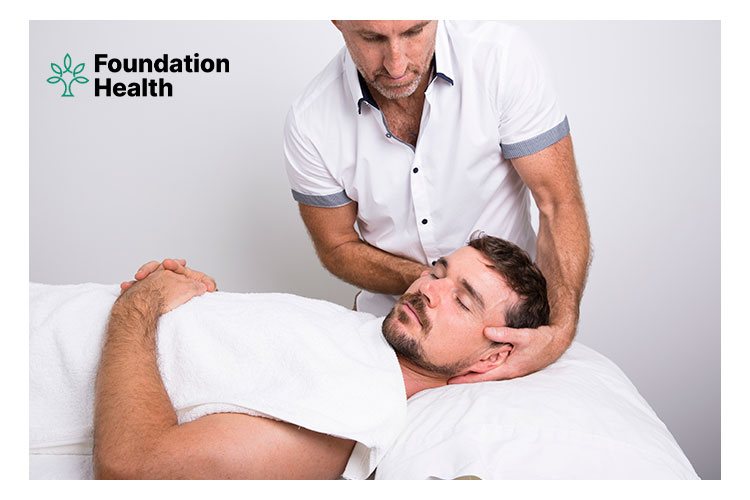
Living with persistent pain can be a lonely and isolating experience. But it doesn’t have to be! Chronic pain is manageable once you know what’s going on in your body and you have an osteopathic treatment plan in place.
Chronic pain is complicated, challenging to treat and recover from. We don’t have a cure for chronic pain patients, but we can help you find pain relief through functional exercises and proven osteopathic strategies that will improve your quality of life.
The sacroiliac (SI) joint is located between the base of your spine and pelvis. It can become inflamed or irritated for a number of reasons, causing significant pain in the lower back and glutes.
Sacroiliac (SI) joint pain affects between 15 and 30% of individuals with chronic, lower back pain.
This type of pain can be difficult to diagnose because it often mimics other conditions such as disc herniation, Joint facet syndrome, and even sciatica.
In order to determine the cause of pain, a thorough physical osteopathic examination is necessary.
SI joint pain (also known as sacroiliac joint dysfunction) refers to the unnatural movement of the joint at the bottom part of the spine that connects the sacrum to the pelvis.
Unnatural movement refers to hypermobility (too much movement in the sacroiliac joint) or hypomobility (too little movement in the sacroiliac joint).
As a result, you may experience pain in your lower back, legs, glutes or sacroiliitis, inflammation of the joints.
The pain from a sacroiliac joint dysfunction may spread to surrounding muscles, resulting in muscle spasms.
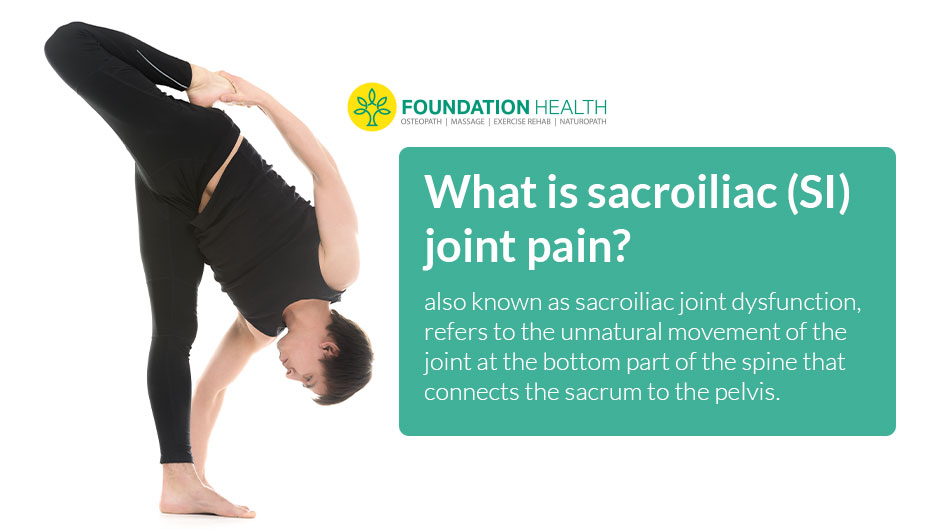
Anything that causes a sudden force to be transmitted down through the pelvis can put a great deal of strain and injury to the SI joint.
Motor vehicle accidents, falls and even childbirth can cause injury to the SI joint.
A biomechanical injury can occur over time, when a person starts a new sport, or when they rapidly increase their level of activity. A twisted pelvis, unequal leg lengths, and muscle imbalances are common biomechanical SI joint injuries.
During pregnancy, hormonal causes of SI joint pain occur when the ligaments of the pelvis become softer and wider in preparation for birth. In addition to causing ligaments to stretch, adding more weight and pressure can lead to injury and pain.
The good news is that with modern medicine, we’re living longer. The bad news is that our joints are wearing out and breaking down as we age.
Degeneration is a normal age-related condition that occurs in most of our joints. It is very well known that we develop arthritis in our hips, knees, and other joints as we age.The role of the Osteopath is to maintain the mobility of the joints as we age.
A subcategory of degeneration is lumbar fusions.
A lumbar fusion is a surgical procedure in which the vertebrae in the lumbar spine (lower back) are joined together, minimising vertebral movement.
When you fuse a joint, you transmit more force to the adjacent joints.
Since the SI joint is considered an adjacent segment (joint) it can therefore degenerate after a prior lumbar or lumbar sacral fusion.
Osteopathic treatment for sacroiliac (SI) joint dysfunction has been shown to provide effective relief for many individuals suffering from this condition. The goal of osteopathic treatment is not only to relieve current symptoms but also to prevent future recurrence of the problem by restoring normal function (where possible) in the affected area.
In order to determine the cause of your sacroiliac joint dysfunction, one of our experienced osteopaths will take a thorough case history, examine you thoroughly, and conduct diagnostic tests to determine the underlying cause.
When treating any aspect of the pelvis, all the structures that make up the pelvis must be aligned and released to create balance and stability between the pelvis and the spine.
To achieve this, our osteopaths use a variety of techniques which may include joint manipulation, joint mobilisation and sports massage depending on the age and severity of the injury or condition.
We may also give you exercises to perform at home and postural advice based on the results of your assessment.
Performing high impact activities such as running, jumping, contact sports, labour intensive jobs, or standing for long periods can aggravate SI joint pain.
Pain can also be aggravated due to weak and deconditioned abdominal, gluteal, and spinal muscles.
When lying down, use pillows to support your hips and pelvis for better alignment to alleviate SI joint pain.
Place a pillow beneath the lower abdomen if you are a stomach sleeper.
If you are a side sleeper, place a pillow between your knees and ankles.
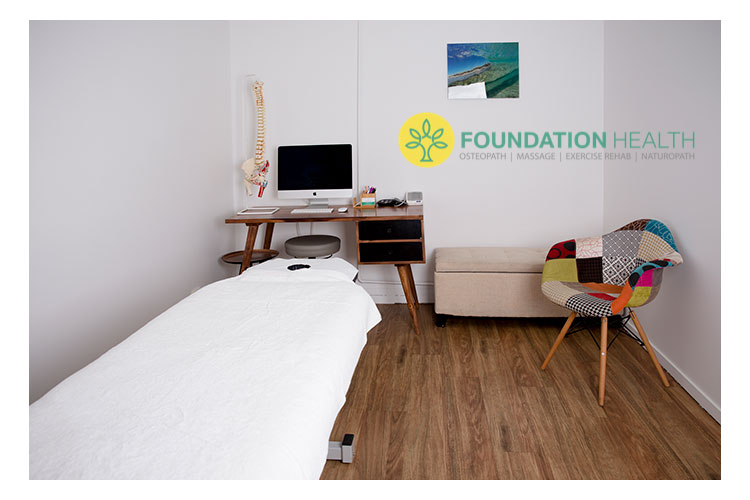
We understand that living in constant pain isn’t easy, which is why we offer osteopathic treatments that are personalised for each patient.
Our goal is to provide relief from pain, increase your mobility, whilst also educating patients about their condition so they can make informed decisions about their care options going forward.
Sciatica is a common condition that causes pain to the sciatic nerve, which runs from your lower back down through each leg. It can be very painful and make it difficult to walk or sit for long periods of time.
If you’re suffering from sciatica, we have good news – there are ways you can relieve your symptoms and get relief fast!
Our osteopathic treatment is designed to target the source of your pain and help reduce inflammation in order to provide lasting relief.
We offer a range of treatments including hands on therapy such as massage, joint manipulation, dry needling, postural advice, and exercise programs so we can find an approach that works best for you.
The sciatic nerve originates at the base of the spine and travels along each side of the leg into the foot, making it the longest and largest nerve in the body.
A common condition that affects the sciatic nerve is sciatica. The term ‘sciatica’ describes the symptoms of pain which radiates from your lower back down through the buttock and into the leg.
It can cause tingling sensations in your foot or toes as well as intense pain and heat sensitivity.
Sometimes the pain is accompanied by numbness or weakness of muscles on one side of your body.
It’s not just your sciatic nerve that’s involved in sciatica – often other parts of your back are affected too.
The causes of sciatica can vary from a minor injury, a muscle imbalance, a herniated disc, a pinched nerve, pregnancy, or obesity to a more serious spinal problem that requires surgery.
Sciatica can also be caused by arthritis of the lower back.
The onset of sciatica can occur suddenly or gradually. The cause determines the onset. For example, a disk herniation can cause sudden pain whereas spinal arthritis develops gradually.
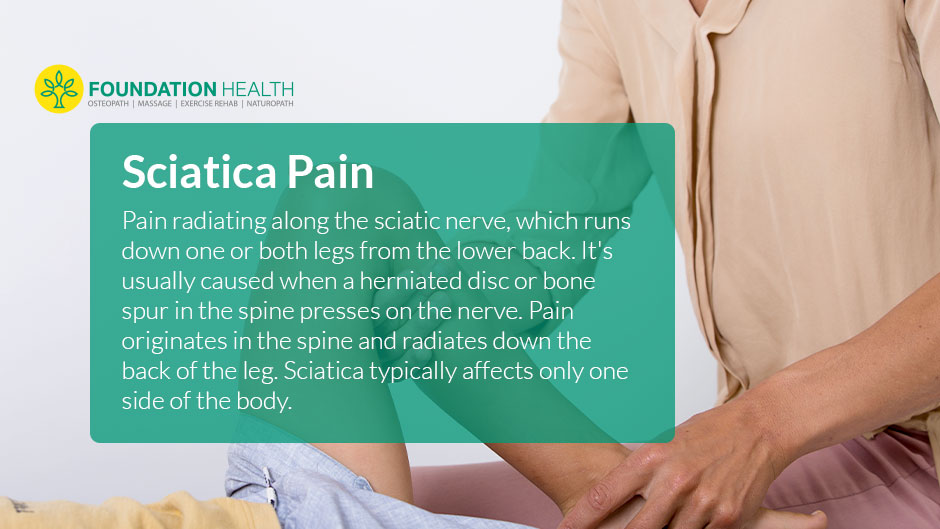
Pain in your buttocks, lower back, and legs. Sciatic pain typically begins in your buttocks and may extend through your entire leg to your foot, sometimes even extending to your heel. If you have sciatica, this sort of pain is likely to be accompanied by other symptoms like tingling, numbness, or muscle weakness.
Numbness and tingling sciatica can cause a pins-and-needles sensation in your buttocks, hips, thighs, and legs. This feeling often begins in the back of your leg (in your calf or thigh) before spreading to your foot. You might also feel a “weird” sensation deep inside the affected hip or leg.
Muscle weakness. You may have great difficulty climbing stairs, walking up slopes, or rising from low seats. This is because sciatica can cause muscle weakness in your legs and feet, making it difficult for you to balance properly. Your buttock muscles may also be weak, making it difficult for you to rise from a sitting position.
Bowel and bladder control problems are another symptom of sciatica because the condition can cause weakness in your leg muscles, leading to poor blood circulation. Loss of feeling or tingling in your feet can also affect your ability to walk properly and balance, which can further affect your bladder control.
The symptoms of sciatica often become worse when leaning backward or forward, sitting for long periods of time, getting up from a seated position, climbing stairs, or lifting heavy objects.
When we treat patients with sciatica, we assess all aspects of the body including posture (how you stand or sit), movement patterns (how you walk), and muscle imbalances (what muscles are tight or weak).
It is worth mentioning that a piriformis injury, particularly one sustained by runners or other endurance athletes, can mimic sciatica due to the proximity of the sciatic nerve to the piriformis muscle. Our osteopathic assessment will determine if this is in fact your situation or not.
We then create an individualised treatment plan that addresses each patient’s specific needs so they get better faster!
Our goal is to help our patients achieve their best possible quality of life by reducing their pain levels through effective treatments while teaching them how to prevent future episodes from occurring again!
This means less time out of work/school/home which equals less money spent on medical bills!
If you’re looking for an effective treatment to help relieve your sciatica symptoms, look no further than Foundation Health osteopathy and massage clinic!
Our experienced team of osteopaths will work with you one-on-one to find a solution that works best for your body.
We have helped countless patients just like you get relief from their sciatica pain without having to resort to surgery or medication!
If you’re looking for pain relief from chronic or acute sciatica, book an appointment with one of our expert osteopaths today!
Is it time to take charge of your health?
OSTEOPATHY EAST BALLINA CLINIC
Is it time to take charge of your health?
Address
2/44 Links Ave, East Ballina, NSW 2478Foundation Health is your local provider of Osteopath services. We offer a wide range of Osteo treatments to the communities surrounding Lennox Head, East Ballina, Ballina, Suffolk Park and Byron Bay.
Take care of all your injuries by booking an appointment today!
